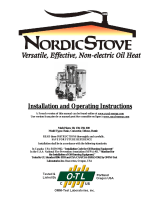
7. BAROMETRIC DAMPER CONTROL
This control, also known as a draft regulator,
automatically maintains a constant negative
pressure in the furnace to obtain maximum
efficiency. It ensures that proper pressures are
not exceeded. If the chimney does not develop
sufficient draft, the draft control cannot function
properly. The draft regulator, when installed
should be in the same room or enclosure as the
furnace and should not interfere with the
combustion air supplied to the burner. The
control should also be located near the furnace
flue outlet and installed according to the
instructions supplied with the regulator. The
overfire draft should be set to -0.02 in. w.c.
8. FAN AND LIMIT CONTROL
The L4064B temperature sensitive fan switch is
actuated by a helical bi-metal sensing element
enclosed in a metal guard, and controls the
circulating air blower. This provides a delay
between the burner ignition and blower start-up
to eliminate excessive flow of cold air when the
blower comes on. Blower shutdown is also
delayed to remove any residual heat from the
heat exchanger and improve the annual
efficiency of the furnace. Fan on settings of 110º
F to 130º F (43º C to 55º C) and fan off settings
of 90º F to 100º F (32º C to 37ºC) will usually be
satisfactory.
The limit switch performs a safety function and
breaks power to oil burner primary control, which
shuts off the burner if the furnace overheats. The
limit control is thermally operated and
automatically resets. The limit control is factory
installed, preset, and is not adjustable.
The limit control and fan control are incorporated
in the same housing and are operated by the
same thermal element.
9. ELECTRICAL CONNECTIONS
The furnace is listed by CSA to the North
American standard. The furnace is factory wired
and requires minimal field wiring. In the United
States, the wiring must be in accordance with the
National Fire Protection Association NFPA-70,
National Electrical Code, and with local codes
and regulations. In Canada, all field wiring
should conform to CAN/CSA C22.1 Canadian
Electrical Code, Part 1, and by local codes,
where they prevail.
The furnace should be wired to a separate and
dedicated circuit in the main electrical panel;
however, accessory equipment such as
electronic air cleaners and humidifiers may be
included on the furnace circuit. Although a
suitably located circuit breaker can be used as a
service switch, a separate service switch is
advisable.
Furnace Power Requirements
Furnace Model
Volts
AC
Amps
Hz
All Models 120 15 1 60
Accessories requiring 120 VAC power sources
such as electronic air cleaners and humidifier
transformers may be powered from the furnace
circuit, but should have their own controls. Do
not use the direct drive motor connections as a
power source, since there is a high risk of
damaging the accessories by exposure to high
voltage from the auto-generating windings of the
direct drive motor.
Thermostat wiring connections and air
conditioning contactor low voltage connections
are shown in the wiring diagram in Appendix B.
Some micro-electronic thermostats require
additional controls and wiring. Refer to the
thermostat manufacturer's instructions.
The thermostat should be located approximately
5 feet above the floor, on an inside wall where
there is good natural air circulation, and where
the thermostat will be exposed to average room
temperatures. Avoid locations where the
thermostat will be exposed to cold drafts, heat
from nearby lamps and appliances, exposure to
sunlight, heat from inside wall stacks, etc.
The thermostat heat anticipator should be
adjusted to the amperage draw of the heating
control circuit as measured at the "R" and "W"
terminals of the thermostat. To reduce the risk of
damaging the heat anticipator, do not measure
this current with the thermostat connected to the
circuit. Measure the amperage by connecting an
ammeter between the two wires that will connect
to the thermostat "R" and "W" terminals.
5




















